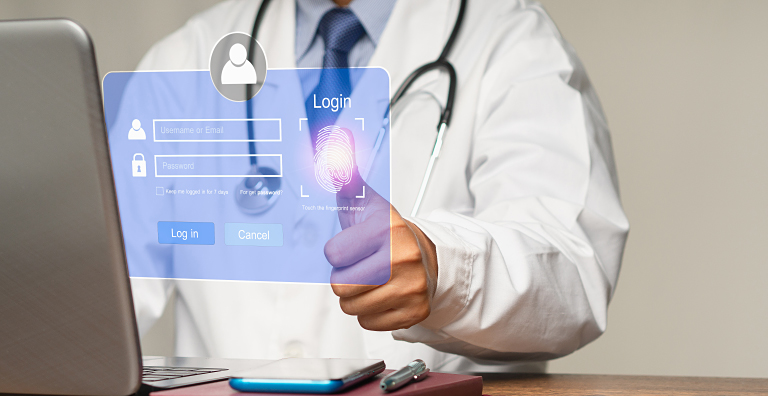Biometrics Are the Missing Link in Healthcare Digital Transformation
Digitization has been a halting, patchwork evolution in many industries, but healthcare may be the one where gaps in digitization cause the most frustration. Care and services must be delivered on time and accurately and may even have life-or-death consequences.
Most access control applications in healthcare still utilize plastic cards or the traditional method of usernames and passwords, whether for employee access to critical systems and supplies, or patient access to insurance or records. Switching to biometric identification and authentication can dramatically increase speed and precision for healthcare providers, improving patient outcomes and even saving lives.
Several of the key healthcare challenges that digitization can help with are yet to be realized. For example, changes introduced through the Health Insurance Portability and Accountability Act (HIPAA) were also intended to help make medical records portable. Another example is positive patient identification. Patient misidentification is a costly and sometimes even fatal, but tragically persistent problem.
Fortunately, the technology to make the necessary changes is available today — biometrics. Proving one’s identity has never been easier. Using unique biometric traits that can’t be forgotten, stolen or shared, this process is all done with speed, accuracy and security.
Data Privacy and Security
Under HIPAA, healthcare organizations are obliged to meet standards for securing access to patient data. Biometric identification scanners can be easily integrated with existing workspaces to help meet this requirement.
HIPAA’s Privacy and Security Rules sets the standard for securing “protected health information” (PHI). The Privacy Rule requires organizations to implement appropriate safeguards to ensure patient confidentiality. The Security Rule stipulates that they must put administrative, physical and technical protections in place for patients’ PHI. Using biometric authentication for access to healthcare records satisfies HIPAA’s technical safeguard requirement.
Unauthorized access is not just a violation of HIPAA, but could also result in a potentially disastrous data breach. Implementing biometrics for log-ins to systems that contain patient records, along with liveness detection to protect against spoofs, eliminates that threat vector.
Controlled Substance Management
Regulations for controlled substances also impose processes that can be time-consuming and inefficient, as well as frustrating for healthcare providers. An identity token linked to a biometric scan removes a common friction point from dispensing medications, while automatically connecting to chain of custody systems for full transparency and auditability.
Electronic Prescriptions for Controlled Substances (EPCS) presents an opportunity for healthcare providers to serve patients remotely, but the identity of both the patient and the prescriber must be verified. EPCS compliance requires two-factor authentication for healthcare professionals signing a prescription. With a mobile biometric EPCS solution, healthcare providers can address the ID proofing and multi-factor authentication (MFA) requirements for remote access for both practitioners and patients.
Secure Sign-On for Staff
A growing number of healthcare organizations have turned to single sign-on (SSO) access to safeguard accounts, patient data and IT systems. While SSO helps to improve user productivity and reduce password management costs, it can introduce its own security risks, so it must be protected with strong authentication.
Biometrics-based SSO can meet the strong authentication needs of the healthcare industry, while also saving valuable seconds compared to passwords or access cards.
The U.S. Department of Veterans Affairs identified superior patient care and enhanced cybersecurity as possible benefits of replacing their PIV cards with biometrics. The organization is now planning a pilot for employees at VA facilities.
Patient Identification and Fraud Prevention
Biometrics provide a means of ensuring positive patient identification with much higher certainty than credentials like ID cards that can be stolen or manipulated to carry out fraud.
Medical insurance fraud is another challenge for the healthcare industry that can be addressed with biometrics. The same technology that provides assurance that staff has the right patient’s files can also prevent one patient from impersonating another to take advantage of their insurance.
Many healthcare facilities are turning to automated patient check-ins to reduce staffing costs and workloads, but this increases the risk of fraud through impersonation. More advanced biometric technology today offers extraordinary presentation attack detection (PAD) and passive liveness detection to combat spoof attempts in unattended use cases. By asking patients to use biometric authentication technology when they check in, healthcare facilities can instantly verify the patient’s identity while offloading the burden on administrative staff.
Visitor Management
The same system can also be easily extended to visitor management. Automated biometric patient and visitor self-service check-in kiosks can help hospitals and other healthcare premises, like hospice and palliative care accommodations and clinics, be more secure and optimize workflow.
Recommendations for Healthcare Organizations
Biometrics providers have been introducing technologies to the market that can address the healthcare industry’s pressing need for stronger identity verification and authentication of patients and staff alike.
Facial recognition technology is well suited to patient-facing applications, particularly as consumers become increasingly accustomed to using their faces to access phones, signing up for bank accounts and passing through the airport.
Fingerprint biometrics provide an easy way for healthcare staff to log in to IT systems. They can also be implemented on credentials like health insurance cards to ensure they cannot be used by imposters, or for physical access to equipment or medications.
Each biometric modality offers its own advantages in terms of performance, security, cost and ease of use. Nevertheless, the potential of biometric authentication is most beneficial to the healthcare facility, its staff and the patients it serves for physical and logical access control, stronger security, improved auditability and accountability.
Explore biometrics in healthcare today to find the applications that can help your healthcare organization.
Additional Resources:
- Learn more about HID’s AI-powered facial recognition technologies
- Find out more about HID fingerprint biometrics
- Explore HID’s comprehensive biometric portfolio
- Subscribe to the HID Biometric Beat monthly eNewsletter
